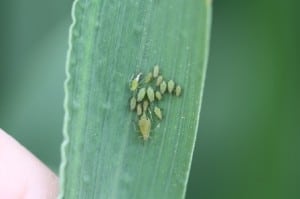Now might be a good time to consider making an insecticide application for aphid control in wheat, and this can be done piggy back with herbicide or fertilizer applications. Dimethoate 4E (8-12 oz/acre) and one of several pyrethroid insecticides are good options (UT Insecticide Recommendation for Wheat).
So when might a springtime application be helpful? Here are some points to consider.
1) An application now would only be needed if the goal is to reduce the transmission of barely yellow dwarf virus by aphids. There will not be enough aphids present currently to directly cause yield loss.
2) You are less likely to see a benefit if you used an insecticide seed treatment (i.e., Cruiser of Gaucho/Imidacloprid), especially considering that almost all our wheat was late planted last fall.
3) There is no point in spraying if you can’t find an aphid, but by the same token, it may be too late to prevent virus transmission if aphids are easy to find. The point is, if you are going to make an application, do it before populations “blow up”.
4) Some states make a recommendation to treat when there are 1-2 aphids per foot of row. Again, this threshold is only to be used if the prevention of virus transmission is the goal, and you are too late when aphids are easily found. We have a fair amount of data in Tennessee showing an average yield response of 4-5 bushels per acre from seed treatments. More limited data shows a positive yield response to an early spring insecticide application if a seed treatment was NOT used. My suspicion is that the combination of a seed treatment plus a springtime foliar application has little value, but I have almost no data to support that hunch.


